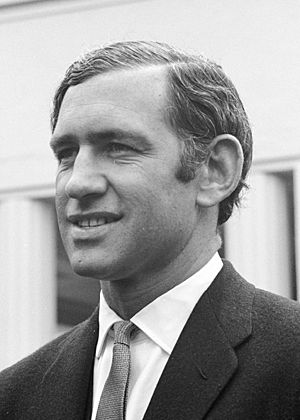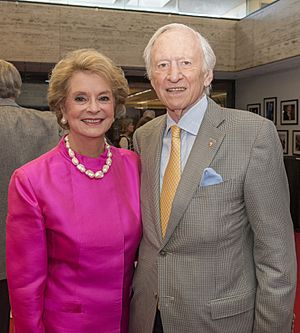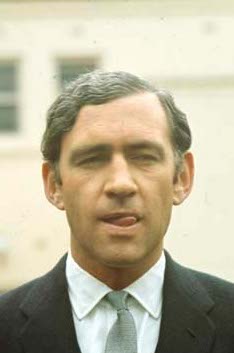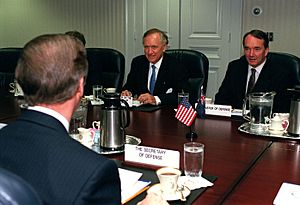Andrew Peacock facts for kids
Quick facts for kids
Andrew Peacock
AC GCL
|
|||||||||||||||||||||||||||||||||||||||||||||||||||||||||||||||
|---|---|---|---|---|---|---|---|---|---|---|---|---|---|---|---|---|---|---|---|---|---|---|---|---|---|---|---|---|---|---|---|---|---|---|---|---|---|---|---|---|---|---|---|---|---|---|---|---|---|---|---|---|---|---|---|---|---|---|---|---|---|---|---|

Peacock in 1969
|
|||||||||||||||||||||||||||||||||||||||||||||||||||||||||||||||
| Leader of the Opposition | |||||||||||||||||||||||||||||||||||||||||||||||||||||||||||||||
| In office 9 May 1989 – 3 April 1990 |
|||||||||||||||||||||||||||||||||||||||||||||||||||||||||||||||
| Prime Minister | Bob Hawke | ||||||||||||||||||||||||||||||||||||||||||||||||||||||||||||||
| Deputy | Fred Chaney | ||||||||||||||||||||||||||||||||||||||||||||||||||||||||||||||
| Preceded by | John Howard | ||||||||||||||||||||||||||||||||||||||||||||||||||||||||||||||
| Succeeded by | John Hewson | ||||||||||||||||||||||||||||||||||||||||||||||||||||||||||||||
| In office 11 March 1983 – 5 September 1985 |
|||||||||||||||||||||||||||||||||||||||||||||||||||||||||||||||
| Prime Minister | Bob Hawke | ||||||||||||||||||||||||||||||||||||||||||||||||||||||||||||||
| Deputy | John Howard | ||||||||||||||||||||||||||||||||||||||||||||||||||||||||||||||
| Preceded by | Bob Hawke | ||||||||||||||||||||||||||||||||||||||||||||||||||||||||||||||
| Succeeded by | John Howard | ||||||||||||||||||||||||||||||||||||||||||||||||||||||||||||||
| 21st Ambassador of Australia to the United States |
|||||||||||||||||||||||||||||||||||||||||||||||||||||||||||||||
| In office 2 February 1997 – 27 February 1999 |
|||||||||||||||||||||||||||||||||||||||||||||||||||||||||||||||
| Nominated by | John Howard | ||||||||||||||||||||||||||||||||||||||||||||||||||||||||||||||
| Preceded by | John McCarthy | ||||||||||||||||||||||||||||||||||||||||||||||||||||||||||||||
| Succeeded by | Michael Thawley | ||||||||||||||||||||||||||||||||||||||||||||||||||||||||||||||
|
|||||||||||||||||||||||||||||||||||||||||||||||||||||||||||||||
|
|||||||||||||||||||||||||||||||||||||||||||||||||||||||||||||||
| Member of the Australian Parliament for Kooyong | |||||||||||||||||||||||||||||||||||||||||||||||||||||||||||||||
| In office 2 April 1966 – 17 September 1994 |
|||||||||||||||||||||||||||||||||||||||||||||||||||||||||||||||
| Preceded by | Robert Menzies | ||||||||||||||||||||||||||||||||||||||||||||||||||||||||||||||
| Succeeded by | Petro Georgiou | ||||||||||||||||||||||||||||||||||||||||||||||||||||||||||||||
| Personal details | |||||||||||||||||||||||||||||||||||||||||||||||||||||||||||||||
| Born |
Andrew Sharp Peacock
13 February 1939 Melbourne, Victoria, Australia |
||||||||||||||||||||||||||||||||||||||||||||||||||||||||||||||
| Died | 16 April 2021 (aged 82) Austin, Texas, U.S. |
||||||||||||||||||||||||||||||||||||||||||||||||||||||||||||||
| Political party | Liberal | ||||||||||||||||||||||||||||||||||||||||||||||||||||||||||||||
| Spouses |
Susan Rossiter
(m. 1963; div. 1978)Margaret Ingram
(m. 1983; div. 1995)Penne Korth
(m. 2002) |
||||||||||||||||||||||||||||||||||||||||||||||||||||||||||||||
| Relations | John Rossiter (father-in-law) | ||||||||||||||||||||||||||||||||||||||||||||||||||||||||||||||
| Children | 3 | ||||||||||||||||||||||||||||||||||||||||||||||||||||||||||||||
| Education | Scotch College | ||||||||||||||||||||||||||||||||||||||||||||||||||||||||||||||
| Alma mater | University of Melbourne | ||||||||||||||||||||||||||||||||||||||||||||||||||||||||||||||
Andrew Sharp Peacock (13 February 1939 – 16 April 2021) was an important Australian politician and diplomat. He served as a government minister and later became the leader of the Liberal Party two times. He led the party in the 1984 and 1990 elections.
Peacock was born in Melbourne, Australia. He went to Scotch College and studied law at the University of Melbourne. He was once the president of the Young Liberals. At just 27 years old, he was elected to Parliament. He took over the seat of Kooyong, which was previously held by Sir Robert Menzies.
In 1969, Peacock became a minister in the government under John Gorton. He also served under William McMahon and Malcolm Fraser. He held many different jobs, including Minister for Foreign Affairs from 1975 to 1980. After the Liberal Party lost the 1983 election, Peacock became their leader.
In the 1984 election, Peacock's party did better than expected. He stepped down as leader in 1985. He then became deputy leader in 1987. Peacock became leader again in 1989. However, he resigned after losing the 1990 election. He left politics in 1994. Later, he became Australia's Ambassador to the United States from 1997 to 1999.
Contents
Early Life and Start in Politics
Andrew Peacock was born on 13 February 1939 in Melbourne, Victoria. His father, Andrew Sharp Peacock Sr, was a marine engineer. He helped start a shipbuilding company.
Andrew went to Scotch College. Then he studied law at the University of Melbourne. In 1963, he married Susan Rossiter. They had three daughters. One of their daughters, Jane Chapple-Hyam, became a horse trainer.
Early Political Steps
Peacock first tried to get into Parliament in the 1961 federal election. He didn't win, but he impressed the Liberal Party leaders. He became president of the Young Liberals in 1962. By 1965, he was the president of the Victorian Liberal Party.
In 1966, former Prime Minister Sir Robert Menzies retired. This opened up his safe seat of Kooyong in Melbourne. Peacock was chosen by the Liberal Party to run for this seat. He won the election easily. He kept his seat in the general election later that year.
Becoming a Minister
In November 1969, Peacock became the Minister for the Army. In 1972, he became the Minister for Territories. In this role, he was in charge of Papua New Guinea, which was an Australian territory. He helped Papua New Guinea move towards becoming self-governing.
When the Liberal Party lost power in 1972, Peacock became an important member of the opposition. He supported the new leader, Billy Snedden. After Snedden lost the 1974 election, Peacock was seen as a possible future leader. However, Malcolm Fraser became leader in 1975.
Fraser made Peacock the spokesperson for foreign affairs. When Fraser became Prime Minister, Peacock became the Minister for Foreign Affairs. He kept this job after the Liberals won the December 1975 election.
He was foreign minister until 1980. He disagreed with Fraser on some issues, like recognizing the Khmer Rouge government in Cambodia. After the 1980 election, he asked for a new job. Fraser made him Minister for Industrial Relations. In 1981, Peacock resigned, saying Fraser interfered too much. He tried to become party leader but didn't succeed. He returned to the government in 1982 as Minister for Industry and Commerce.
Leading the Liberal Party
The Liberal government lost the March 1983 election to the Labor Party, led by Bob Hawke. After this, Fraser retired. Peacock then became the leader of the Liberal Party. John Howard became his deputy.
As the leader of the opposition, Peacock faced a tough challenge. Bob Hawke was very popular.
The 1984 Election
In the 1984 election, many thought Peacock had little chance to win. However, he did better than expected. He managed to reduce Hawke's majority in Parliament.
In 1985, Peacock's popularity dropped. He tried to replace his deputy, John Howard. But the party members voted to keep Howard as deputy. Even though Peacock had more support in the party, he resigned on 5 September 1985. He felt he could not continue. Howard then became the opposition leader.
Return to Leadership
Howard lost the 1987 election. After this, Peacock challenged Howard for the leadership. He lost, but he was elected deputy leader. Peacock's supporters continued to work for him. In May 1989, Peacock became leader again. He was 50 years old and presented a more mature image.
At the 1990 election, Peacock's party won more votes overall. They also gained seven seats from Labor. However, it was not enough to make Peacock prime minister. He resigned after the election. He promised not to try for the leadership again. He continued to serve in important roles in the opposition. He supported John Hewson as the new leader.
After Hewson lost the 1993 election, Peacock returned to the foreign affairs role. He kept this role when Alexander Downer became leader.
After Parliament
Peacock left Parliament on 17 September 1994. In 1996, when John Howard became Prime Minister, he appointed Peacock as Australia's Ambassador to the United States. This meant Peacock represented Australia in America. He served in this role from 1997 to 1999. After his time as ambassador, Peacock mostly lived in the United States.
In 2002, he married Penne Percy Korth. She was a well-known figure in Washington, D.C. and a former US Ambassador to Mauritius. Peacock also worked for Boeing Australia Holdings as its President. He retired from Boeing in 2007. He then became chairman of a company called MFS Ltd. He resigned from this role before the company faced financial problems.

Peacock and his wife lived in Austin, Texas. He visited Australia regularly. He supported Donald Trump in the 2016 US presidential election. He later shared his thoughts on American politics, noting the political differences between himself and his wife.
His Legacy
Peacock passed away at his home in Austin, Texas, on 16 April 2021, at the age of 82. Many people remembered his important work in Australian foreign policy and international relations. They said he left a lasting mark on the country.
His former rival, John Howard, said Peacock was a "hugely significant figure" in Australian politics. He praised Peacock as an "outstanding foreign minister." Howard also noted Peacock's role in helping Papua New Guinea become independent.
Then-Prime Minister Scott Morrison called Peacock "one of our greatest Liberals." He praised Peacock's strong stance against the Pol Pot regime in Cambodia. Many other political leaders from both sides also paid tribute to him.
A special memorial service for Peacock was held at St Paul's Cathedral in Melbourne on 11 February 2022.
Honours
In 1997, Peacock was given the honour of Companion of the Order of Australia.
In 2006, he was appointed a Chief Grand Companion of the Order of Logohu. This was for his role in helping New Guinea become independent.
In 2017, the government of Japan gave Peacock the Grand Cordon of the Order of the Rising Sun. This was for his work in making friendly relations stronger between Japan and Australia.
Images for kids
See Also
- List of Australian Leaders of the Opposition
- List of Ambassadors of Australia to the United States







